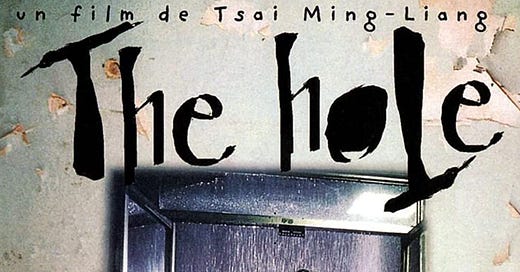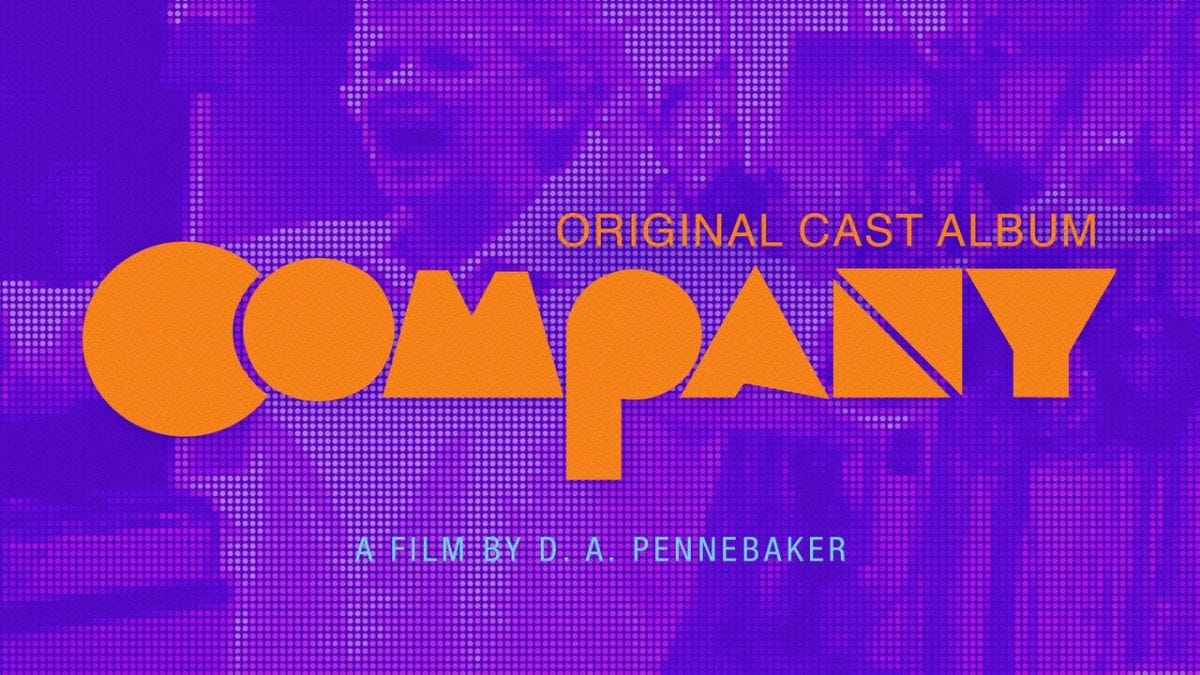Issue 13
This week we peruse the musical collection of The Criterion Channel and dip our toes into the 1998 Taiwanese pandemic musical, The Hole.
• With Steven Spielberg finally making a musical, this article looks back at all the musical films to come from the “New Hollywood” directors. [Film School Rejects]
• A look back at a turning point in movie musical history, this article shows us the landscape that brought about the diegetic musical revolution with an adaptation of Cabaret. [Collider]
• Is 2021 the Start of a New Musical Golden Age? A recap of this year’s movie musical cornucopia. [Harper’s Bazaar]
• “Schmigadoon! … So silly it’s spectacular!” A review of the new AppleTV musical show that does a good job detailing what works and what doesn’t. [Varsity]
Annette is currently the #4 most streamed movie on Amazon Prime. It’s controversial among filmgoers and musical lovers and we’re gearing up to talk about it next issue, so watch it if you haven’t! Here’s a New York Times review.
“You have people on Facebook and Twitter trying to lead these reductive discussions about what’s good or bad,” [Leos Carax, the director of Annette] said. “Yet a film is about putting your doubts and stupidity onscreen. If you don’t do that, you have to be a master, like Hitchcock or Bresson. I’m not a master.”
• More on Carax and Annette on the New York Times [NYT]
We love that the Criterion Collection exists to preserve classic, obscure and noteworthy movies. Their box sets are beautifully designed, chock full of special features and always come with a thoughtful, and informative booklet. Their streaming service, The Criterion Channel, is no less exciting with additional videos that accompany most everything on the site.
Annie
The original movie musical directed by John Huston. The criterion collection calls it “a ray of cinematic sunshine” and we couldn’t agree more.
Bells Are Ringing
Judy Holliday’s final film appearance (reprising a role she won a Tony for), directed by Vincent Minnelli.
Golden Eighties
A feminist musical about “love and survival in the age of late capitalism” made in France and Belgium in the 80s. If that was late capitalism, what are we in now?
Hedwig and the Angry Inch
A groundbreaking indie cinematic experience. The story was ahead of its time, both in terms of content and technique. It blurs the line between true musical numbers and performance numbers. It includes animation and sets that break apart and turn into stages. Nothing has been made since Hedwig that has really moved the needle on what a movie musical can be.
The Lure
A Polish rock fueled erotic mermaid musical that is disturbing and magical all at the same time. Includes some inspired musical numbers, though it could have used a few more.
The Umbrellas of Cherbourg
We’ve written about this before (it’s also available on Kanopy). Watch it if you haven’t. Truly masterful.
Two musicals also by Jaque Demy and on Criterion are ...
The Young Girls of Rochefort
The follow-up to Umbrellas made 5 years later in 1967, it’s another musical about missed connections. It’s bigger, it’s bolder and it has Gene Kelly.
Une Chambre en Ville
A lesser known musical tragedy. It’s political, darker, made much later in 1982 (compared to 1962 for Umbrellas), and we haven’t seen it.
Zou Zou
A 1934 French backstage musical a la 42nd Street. There’s a number where Zou Zou is clad in feathers sitting on a swing in an oversized birdcage. That’s all we know and it’s enough to make us watch it.
Criterion Bonuses!
A documentary, a featurette, and a DVD boxed set. Yep you read that right.
Original Cast Album: “Company”
This long-unavailable documentary has become legendary, particularly after it was spoofed in Documentary Now: “Co-op”. For a first hand look into the process of recording a cast album (how they used to do it at least) and insight into Sondheim, this is worth a month of Criterion all on its own.
Several Featurettes
There are some neat featurettes on Criterion including a discussion on the music of Charlie Chaplin (who wrote his own scores for his movies) and ten jazz shorts, which were mini-musicals featuring Louis Armstrong, Billie Holliday and Bing Crosby meant as preludes for feature films. Sign me up!
Four Lubitsch Musicals
The Criterion Collection sells a box set of the four musicals by director Ernst Lubitsch made from 1929-1932. He pioneered camera movement never before seen on film that was then copied by directors for years to come, setting the standard for how to film musical sequences in a movie musical. His camera technique has become known as the “Lubitsch Touch” because it is so smooth, cuts are almost invisible. If you’re to watch only one of them, make it “One Hour With You.” It’s the last and best of the four and actually a remake of his earlier silent film, “The Marriage Circle.”
The Hole (1998)
While never-ending rain and a strange disease spread by cockroaches ravage Taiwan, a plumber makes a hole between two apartments and the inhabitants of each form a unique connection, enacted in musical numbers. (IMDb)
Directed by Tsai Ming-liang
Music by Grace Chang
The Hole is a seemingly prescient movie, presenting a pandemic world that seems all too familiar; hoarding toilet paper, spread of misinformation, and a feeling of complete isolation. It’s a cinematic slow burn about two lonely characters aptly named “The Man Upstairs” and “The Woman Downstairs” that become connected by a small hole between their two apartments. The movie is exceptionally crafted, and while there’s a lot to say of the movie as a whole, we’re here to focus specifically on the musical sequences.
We’re hard pressed to call it a movie musical since the songs are all fantasy sequences and they are all pre-existing songs. Still, there’s plenty to be said about how the music functions in the story.
To begin, let’s skip to the end. The film closes with a quote from director Tsai Ming-liang: “In the year 2000*, we are grateful that we still have Grace Chang’s songs to comfort us.” The songs in this film are all from Grace Chang, a 1950’s pop idol, and they are used as a means of escape from the harsh (and wet) reality our characters are living in—or perhaps better put, a means of survival.
*The film was conceived as part of the French television project “2000, Seen By…”—a series of 10 short-ish films where auteurs were invited to speculate on what the new millennium might bring. It then went on to win the International Critics’ Prize at the 1998 Cannes Film Festival.
The songs are an extension of The Woman Upstairs. The first song is hers alone, in the following song she is joined by backup singers, and ultimately The Man Upstairs finds his way into the sequences, but they are always from her perspective and these songs are the only place she has control.
The contrast between the songs and the rest of the movie is striking and what makes the movie so unique. The first, “Calypso” is so jarring because it’s such a fun celebrational song compared to the drab world we’ve been inhabiting for the last ten minutes. I could almost imagine this has been her coping song throughout the pandemic. It’s not so different from “Castle on a Cloud,” though staying grounded within the world and infused with Calypso flair.
All the songs never leave the confines of the apartment complex, so while these sequences are fantasy, those fantasies are firmly rooted in the world of which they are living. In the next song, “Tiger Woman,” the Woman and a group of backup singers patrol the staircase singing a character assasination of a song with searing lines such as, “you’re penniless, completely useless, what a nasty jealous sod.” Granted, he did vomit into her house.
What gets our character to sing is also fascinating. Miniscule interactions are enough to launch this movie into song. A mere glimpse from the balcony begins the third song, “I Want Your Love.” At this point, we’re halfway through the movie and our two characters have barely interacted with each other beyond exchanging a few words and some passive aggressive behaviours through the hole. Having just finished over a year of quarantine, it’s not hard to imagine how little human interaction is required to send your imagination spiraling.
When the Woman comes down with a sickness, a simple sneeze launches us into “Achoo Ha Ha.” Featuring backup dancers galore, this is the most visually stunning and vibrant sequence, which contrasts beautifully to the fact that our heroine is probably going to die.
The film comes to a close with the heart wrenching song “I Don’t Care Who You Are.” This sequence is stripped of inventive lighting and dancing. It’s also stripped of lip syncing. The only fantastical element is that our characters are wearing a dress and a white tux, as they slow-dance together in the Man’s dreary apartment. Just two human beings making physical contact, which is all our two characters have longed for the entire movie.
Ultimately, the film is a powerful reminder of the importance of music as a means of escape, as a means of spreading joy, and as a means of coping with reality—and there’s no better time for musicals than in a pandemic.
Help us reach more Movie Musical lovers and forward this email to anybody you think may love it! This is our first issue and we're excited to build our audience.
Was this forwarded to you? Subscribe Here.
ABOUT THIS EMAIL
"Rooster Revue" is edited by Matt Andrews and Jeffrey Simon with contributions from the entire team at The Barn. Read past issues in the archive.

















